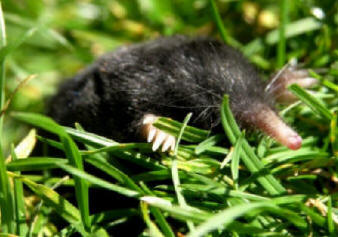

< >
WILDLIFE OF AFGHANISTAN WILDLIFE OF SAUDI ARABIA NORTHWEST WILDLIFE ONLINE
Golden Moles, Moon Rats, Desmans, Water Shrews, Solenodons. Sounds like a list of creatures from Middle Earth of Hobbit land does it not? But unlike our friend Bilbo these odd animals actually exist; hundreds of different species of them live side by side with modern man spread throughout the globe. They are surely creatures of the earth and some of the most ancient land mammals ever to inhabit our world. Most of us are familiar with moles, of course. Their mounds of black dirt decorate lawns and gardens everywhere. But the order of mammals we call Insectivora includes a plethora of wonderful wildlife from spiny hedgehogs to shrews the size of an otter.
On the far left a Shrew Mole makes a rare appeareance and peaks through the grass jungle. A shrew, temporarily captured in a tin can, displays the plump little body and sharp nose of the species. Moles dwell below ground while shrews inhabit the underside of leaf litter and such, but are not burrowers. But if you really wish to know more about the amazing animals please check out Dr. Thompson's book, "Of Moles and Men."
First a note about the classification of these animals. Thanks to science of molecular biology the species classification of many animals has changed considerably, and this is especially true in the order still commonly known as Insectivora. In the 1970s the animals were then classified under an order called Insectivora and boasted eight families. By the 1990s the order Insectivora had been dropped and replaced by the order Eulipotyphyla. Along with that change a number of species were reclassified into other orders of mammals. Whatever. Although the term Insectivora may have been scientifically retired a good portion of the interested public remains familiar with the name and hence the title of this article.
As of the year 2000, according to the most recent lineatic acrobatics, the order now consists of five families. The late Patrick Thompson, PhD, a renowned expert of the topic lists them as follows in his book “Of Moles and Men: The Battle for the Turf.”
· Chrysochloridae Golden Moles - Madagascar and Africa
· Erincidae Hedgehogs and Moonrats - Africa and Eurasia
· Solenodontidae Solenodons - Cuba and Hipaniola
· Soricida Shrews – Africa, Eurasia, North and South America
· Talpidae Moles, Desmans, Shrew-moles – Asia and North America
· Tenrecidae Tenrecs and Otter Shrews - Africa
The secretive subterranean lifestyle of insectivores is borne of a long standing tradition – millions and millions of years of tradition, in fact. At some point during the Mesozoic Period (225-65 million years ago) when the great dinosaurs dominated earth, tiny mammal like creatures began to appear. These little guys had no chance of competing against the great giants that stomped about the fields and forests, but there was an ecological niche where they could flourish in relative safety – the forest undergrowth. Insectivores are descendants of these early mammals and for the most part they have carried forth their underground way of life. Even their appearance is relatively unchanged. They are small animals with a long snout and tiny eyes. Most sources refer to their “primitive” teeth. Basically this means that their teeth pointed incisors and are not overly specialized such as those seen in rodents.
Insectivores may be an ancient group of mammals but this down to earth lifestyle has proven very successful. And this success is, ironically enough, a mirror of their survival amidst the dinosaurs. While the big creatures called humans dominate the earth and destroy the habitat of other large creatures the insectivores in their subterranean niche have found the perfect hiding place. Humans, in fact, have altered the environment in many ways that suit these animals quite nicely, thank you very much. Lawns and gardens make wonderful homes for moles and shrews. Hedgehogs are extremely pleased with the European passion for hedges from which their name is derived; they’ve even become a favored pet. So it seems that our primitive toothed friends will be around for several more millennia.
In part 2 of this article we’ll take a look at our resident insectivores of the Northwest.
HOOAH
Jack
< >
WILDLIFE OF AFGHANISTAN WILDLIFE OF SAUDI ARABIA NORTHWEST WILDLIFE ONLINE
Saudi Arabian Wildlife Afghanistan Wildlife